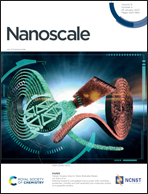Alloying and dealloying of Au18Cu32 nanoclusters at precise locations via controlling the electronegativity of substituent groups on thiol ligands†
Abstract
The doping site of metals in an alloy nanocluster plays a key role in determining the cluster properties. Herein, we found that alloying engineering was achieved by replacing Cu at specific positions in the second layer Cu20 shell of the [Au18Cu32(SR–O)36]2− or [Au18Cu32(SR–F)36]3− (SR–O = –S–PhOMe; SR–F = –SC6H33,4F2) nanocluster with Au to generate a core–shell [Au20.31Cu29.69(SR–O)36]2− protected by mercaptan ligands with electron-donating substituents, which could be stable obtained compared with the alloyed nanocluster with electron-withdrawing substituent ligands. Moreover, dealloying engineering was accomplished by an electron-withdrawing substituent ligand exchange strategy (i.e., [Au18Cu32(SR–F)36]2−). The abovementioned reaction was analyzed using single-crystal X-ray crystallography, electrospray ionization mass spectrometry, and X-ray photoelectron spectroscopy and monitored via time-dependent ultraviolet-visible absorption spectroscopy. This reversible and precise location of alloying and dealloying provides the possibility for studying the relationship between the structure and properties of nanoclusters at the atomic level.

- This article is part of the themed collection: Nanoscale 2023 Emerging Investigators


 Please wait while we load your content...
Please wait while we load your content...